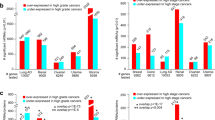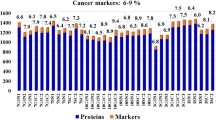Abstract
Two-dimensional isoelectric focusing and gel electrophoresis followed by mass spectrometry were used to detect, measure, and identify changes in protein expression correlated with differences in the metastatic potential of cultured rat mammary adenocarcinoma cells. MTC is a non-metastatic cell clone derived from a primary tumor. MTLn2 and MTLn3 are low and high metastatic potential cell clones derived from lung metastases of the primary tumor. A total of 1,500 proteins was detected. The patterns of protein expression of MTLn2 and MTLn3 cells were similar. Only five spots had a threefold or greater statistically significant difference in staining intensity between MTLn2 and MTLn3 cells, whereas 70 spots differed between MTC and MTLn3 cells. Twenty spots were selected for further study, ten that had a positive correlation of staining intensity with metastatic potential and ten that had a negative (inverse) correlation. Of the 17 unique proteins that were identified, five have often been cited as tumor biomarkers. These included the positive biomarkers nucleophosmin (NPM) and 14-3-3 protein sigma and the negative biomarkers raf kinase inhibitor protein (RKIP), peroxiredoxin-2, and galectin-1. The only identified protein that was markedly higher in MTLn3 cells than in the less-metastatic MTLn2 cells was 14-3-3 protein sigma. The results indicate that increased metastatic potential is associated with positive and negative changes in expression of particular proteins. Proteins that are positively correlated with metastatic potential may prove more useful as clinical biomarkers, but those with negative correlations may still provide useful information about underlying mechanisms of metastatic spread.



Similar content being viewed by others
Abbreviations
- 2-DG:
-
Two-dimensional isoelectric focusing and gel electrophoresis
- IEF:
-
Isoelectric focusing
- NPM:
-
Nucleophosmin
- RKIP:
-
Raf kinase inhibitor protein
- SDS:
-
Sodium dodecyl sulfate
- UTC:
-
Urea, thiourea, CHAPS solubilization solution
References
Brünner N, Holten-Andersen M, Sweep F et al (2008) New tumor biomarkers: practical considerations prior to clinical application. In: Daoud SS (ed) Cancer proteomics from bench to bedside. Human Press, Totowa, pp 189–207
Verma M, Srivastava S (2003) New cancer biomarkers deriving from NCI early detection research. Recent Results Cancer Res 163:72–84 discussion 264–266
Harris L, Fritsche H, Mennel R et al (2007) American Society of Clinical Oncology 2007 update of recommendations for the use of tumor markers in breast cancer. J Clin Oncol 25:5287–5312
Couzin J (2009) Biomarkers. Metabolite in urine may point to high-risk prostate cancer. Science 323:865
Li H, He Y, Ding G et al (2010) dbDEPC: a database of differentially expressed proteins in human cancers. Nucl Acids Res 38:D658–D664
Conrads TP, Hood BL, Petricoin EF 3rd et al (2005) Cancer proteomics: many technologies, one goal. Expert Rev Proteomics 2:693–703
Reymond MA, Schlegel W (2007) Proteomics in cancer. Adv Clin Chem 44:103–142
Rajcevic U, Niclou SP, Jimenez CR (2009) Proteomics strategies for target identification and biomarker discovery in cancer. Front Biosci 14:3292–3303
Neri A, Welch D, Kawaguchi T et al (1982) Development and biologic properties of malignant cell sublines and clones of a spontaneously metastasizing rat mammary adenocarcinoma. J Natl Cancer Inst 68:507–517
Ramshaw IA, Badenoch-Jones P (1985) Studies on rat mammary adenocarcinomas: a model for metastasis. Cancer Metastasis Rev 4:195–208
Atnip KD, Carter LM, Nicolson GL et al (1987) Chemotactic response of rat mammary adenocarcinoma cell clones to tumor-derived cytokines. Biochem Biophys Res Commun 146:996–1002
Dabbous MK, Haney L, Nicolson GL et al (1991) Mast cell modulation of tumour cell proliferation in rat mammary adenocarcinoma 13762NF. Br J Cancer 63:873–878
Pencil SD, Toh Y, Nicolson GL (1993) Candidate metastasis-associated genes of the rat 13762NF mammary adenocarcinoma. Breast Cancer Res Treat 25:165–174
Toh Y, Pencil SD, Nicolson GL (1995) Analysis of the complete sequence of the novel metastasis-associated candidate gene, mta1, differentially expressed in mammary adenocarcinoma and breast cancer cell lines. Gene 159:97–104
Pencil SD, Toth M (1998) Elevated levels of annexin I protein in vitro and in vivo in rat and human mammary adenocarcinoma. Clin Exp Metastasis 16:113–121
Levea CM, Mcgary CT, Symons JR et al (2000) PTP LAR expression compared to prognostic indices in metastatic and non-metastatic breast cancer. Breast Cancer Res Treat 64:221–228
Bouzahzah B, Albanese C, Ahmed F et al (2001) Rho family GTPases regulate mammary epithelium cell growth and metastasis through distinguishable pathways. Mol Med 7:816–830
Wang W, Wyckoff JB, Frohlich VC et al (2002) Single cell behavior in metastatic primary mammary tumors correlated with gene expression patterns revealed by molecular profiling. Cancer Res 62:6278–6288
van Nimwegen MJ, Verkoeijen S, van Buren L et al (2005) Requirement for focal adhesion kinase in the early phase of mammary adenocarcinoma lung metastasis formation. Cancer Res 65:4698–4706
Xue C, Wyckoff J, Liang F et al (2006) Epidermal growth factor receptor overexpression results in increased tumor cell motility in vivo coordinately with enhanced intravasation and metastasis. Cancer Res 66:192–197
Sidani M, Wessels D, Mouneimne G et al (2007) Cofilin determines the migration behavior and turning frequency of metastatic cancer cells. J Cell Biol 179:777–791
Wang W, Wyckoff JB, Goswami S et al (2007) Coordinated regulation of pathways for enhanced cell motility and chemotaxis is conserved in rat and mouse mammary tumors. Cancer Res 67:3505–3511
Hernandez L, Smirnova T, Kedrin D et al (2009) The EGF/CSF-1 paracrine invasion loop can be triggered by heregulin {beta}1 and CXCL12. Cancer Res 69:3221–3227
Marxfeld H, Staedtler F, Harleman JH (2006) Characterisation of two rat mammary tumour models for breast cancer research by gene expression profiling. Exp Toxicol Pathol 58:133–143
Wilkins MR, Pasquali C, Appel RD et al (1996) From proteins to proteomes: large scale protein identification by two-dimensional electrophoresis and amino acid analysis. Nat Biotechnol 14:61–65
Srinivas PR, Verma M, Zhao Y et al (2002) Proteomics for cancer biomarker discovery. Clin Chem 48:1160–1169
Alaiya A, Al-Mohanna M, Linder S (2005) Clinical cancer proteomics: promises and pitfalls. J Proteome Res 4:1213–1222
Iwadate Y (2008) Clinical proteomics in cancer research-promises and limitations of current two-dimensional gel electrophoresis. Curr Med Chem 15:2393–2400
Zhang K, Wrzesinski K, Stephen JF et al (2008) Comparative proteome analysis of three mouse lung adenocarcinoma CMT cell lines with different metastatic potential by two-dimensional gel electrophoresis and mass spectrometry. Proteomics 8:4932–4945
Sitek B, Sipos B, Alkatout I et al (2009) Analysis of the pancreatic tumor progression by a quantitative proteomic approach and immunhistochemical validation. J Proteome Res 8:1647–1656
Sommers CL, Heckford SE, Skerker JM et al (1992) Loss of epithelial markers and acquisition of vimentin expression in adriamycin- and vinblastine-resistant human breast cancer cell lines. Cancer Res 52:5190–5197
Okuwaki M (2008) The structure and functions of NPM1/Nucleophosmin/B23, a multifunctional nucleolar acidic protein. J Biochem 143:441–448
Grisendi S, Mecucci C, Falini B et al (2006) Nucleophosmin and cancer. Nat Rev Cancer 6:493–505
Mhawech P (2005) 14-3-3 proteins—an update. Cell Res 15:228–236
Keller ET, Fu Z, Yeung K et al (2005) The biology of a prostate cancer metastasis suppressor protein: raf kinase inhibitor protein. J Cell Biochem 1:273–278
Klysik J, Theroux SJ, Sedivy JM et al (2008) Signaling crossroads: the function of raf kinase inhibitory protein in cancer, the central nervous system and reproduction. Cell Signal 20:1–9
Granovsky AE, Rosner MR (2008) Raf kinase inhibitory protein: a signal transduction modulator and metastasis suppressor. Cell Res 18:452–457
Fu Z, Kitagawa Y, Shen R et al (2006) Metastasis suppressor gene raf kinase inhibitor protein (RKIP) is a novel prognostic marker in prostate cancer. Prostate 66:248–256
Fu Z, Smith PC, Zhang L et al (2003) Effects of raf kinase inhibitor protein expression on suppression of prostate cancer metastasis. J Natl Cancer Inst 95:878–889
Neumann CA, Fang Q (2007) Are peroxiredoxins tumor suppressors? Curr Opin Pharmacol 7:375–380
Petrak J, Ivanek R, Toman O et al (2008) Deja vu in proteomics. a hit parade of repeatedly identified differentially expressed proteins. Proteomics 8:1744–1749
Gromov P, Gromova I, Bunkenborg J et al (2010) Up-regulated proteins in the fluid bathing the tumour cell microenvironment as potential serological markers for early detection of cancer of the breast. Mol Oncol 4:65–89
Camby I, Le Mercier M, Lefranc F et al (2006) Galectin-1: a small protein with major functions. Glycobiology 16:137R–157R
Salatino M, Croci DO, Bianco GA et al (2008) Galectin-1 as a potential therapeutic target in autoimmune disorders and cancer. Expert Opin Biol Ther 28:45–57
Wu MH, Hong TM, Cheng HW et al (2009) Galectin-1-mediated tumor invasion and metastasis, up-regulated matrix metalloproteinase expression, and reorganized actin cytoskeletons. Mol Cancer Res 7:311–318
Thijssen VL, Postel R, Brandwijk RJ et al (2006) Galectin-1 is essential in tumor angiogenesis and is a target for antiangiogenesis therapy. Proc Natl Acad Sci USA 103:15975–15980
Daroqui CM, Ilarregui JM, Rubinstein N et al (2007) Regulation of galectin-1 expression by transforming growth factor beta1 in metastatic mammary adenocarcinoma cells: implications for tumor-immune escape. Cancer Immunol Immunother 56:491–499
Rabinovich GA, Liu FT, Hirashima M et al (2007) An emerging role for galectins in tuning the immune response: lessons from experimental models of inflammatory disease, autoimmunity and cancer. Scand J Immunol 66:143–158
Jung EJ, Moon HG, Cho BI et al (2007) Galectin-1 expression in cancer-associated stromal cells correlates tumor invasiveness and tumor progression in breast cancer. Int J Cancer 120:2331–2338
Saussez S, Lorfevre F, Lequeux T et al (2008) The determination of the levels of circulating galectin-1 and -3 in HNSCC patients could be used to monitor tumor progression and/or responses to therapy. Oral Oncol 44:86–93
Saussez S, Glinoer D, Chantrain G et al (2008) Serum galectin-1 and galectin-3 levels in benign and malignant nodular thyroid disease. Thyroid 18:705–712
Chiang WF, Liu SY, Fang LY et al (2008) Overexpression of galectin-1 at the tumor invasion front is associated with poor prognosis in early-stage oral squamous cell carcinoma. Oral Oncol 44:325–334
Acknowledgments
Supported in part by the Sam Mount, Jr. Endowment for Oral Cancer Research, the International Cancer Research Fund, and the University of Tennessee Health Science Center College of Dentistry Alumni Endowment Fund.
Author information
Authors and Affiliations
Corresponding author
Rights and permissions
About this article
Cite this article
Dabbous, M.K., Margaret Jefferson, M., Haney, L. et al. Biomarkers of metastatic potential in cultured adenocarcinoma clones. Clin Exp Metastasis 28, 101–111 (2011). https://doi.org/10.1007/s10585-010-9362-8
Received:
Accepted:
Published:
Issue Date:
DOI: https://doi.org/10.1007/s10585-010-9362-8




